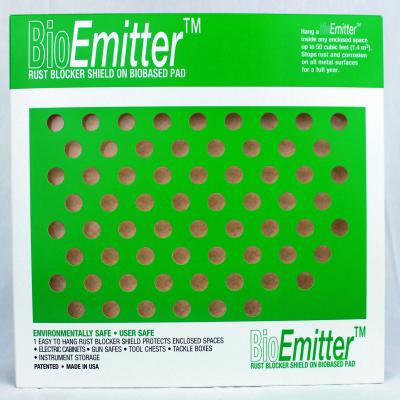
Cortec’s BioEmitter offers easy-to-use protection from rust and corrosion on metals stored in enclosed spaces as large as 50 cubic feet (1.4m3). Simply attach the environmentally safe BioEmitter onto a clean surface inside an enclosed area, then relax knowing your tools, electric panels or other metallic valuables are protected.
The BioEmitter takes up less than 1 sq. ft. of space and is conveniently packaged in a vented cardboard box; allowing Cortec’s innovative Vapor phase Corrosion Inhibitors (VpCIs) to migrate throughout the surrounding space to form an invisible molecular shield on metal surfaces, sealing off air and moisture - even in the hardest to reach areas. The BioEmitter provides long-term protection against corrosion even in the presence of adverse conditions including salt, moisture, airborne contaminants, H2S, SO2, NH3, and others.
Cortec’s BioEmitter is made with bio-based, renewable materials; the VpCIs are non-toxic and do not contain nitrates, silicones, phosphates, or heavy metals. They also have no adverse effects on electrical or chemical properties, and do not harm plastics, elastomers, or painted surfaces.
The BioEmitter protects a wide variety of metals from rust and corrosion. These metals include mild steel, galvanized steel, brass, solder, cast iron, silver, aluminum alloys, magnesium alloys, copper and copper-nickel alloys.
Contact Details
Related Glossary Terms
- alloys
alloys
Substances having metallic properties and being composed of two or more chemical elements of which at least one is a metal.
- aluminum alloys
aluminum alloys
Aluminum containing specified quantities of alloying elements added to obtain the necessary mechanical and physical properties. Aluminum alloys are divided into two categories: wrought compositions and casting compositions. Some compositions may contain up to 10 alloying elements, but only one or two are the main alloying elements, such as copper, manganese, silicon, magnesium, zinc or tin.

